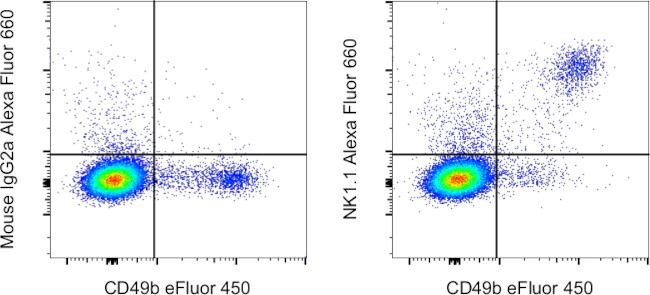Search Thermo Fisher Scientific
Invitrogen
NK1.1 Monoclonal Antibody (PK136), Alexa Fluor™ 660, eBioscience™
FIGURE: 1 / 1
NK1.1 Antibody (606-5941-82) in Flow

Product Details
606-5941-82
Species Reactivity
Host/Isotype
Recommended Isotype Control
Class
Type
Clone
Conjugate
Excitation/Emission Max
Form
Concentration
Purification
Storage buffer
Contains
Storage conditions
Shipping conditions
RRID
Product Specific Information
Description: The PK136 monoclonal antibody reacts with mouse NK1.1, an antigen expressed by natural killer cells and a subset of T cells in the NK1.1 mouse strains including C57BL and NZB. Several commonly used laboratory mouse strains such as BALB/c, SJL, AKR, CBA, C3H and A do not express the NK1.1 antigen. For detection of NK cells in these strains the monoclonal antibody DX5 (Product # 14-5971) should be used. Simultaneous staining of C57BL/6 spleen cells with PK136 and DX5 reveals coexpression of both markers by a majority of cells as well as presence of small populations of DX5+PK136- and DX5-PK136+ cells.
Applications Reported: This PK136 antibody has been reported for use in flow cytometric analysis.
Applications Tested: This PK136 antibody has been tested by flow cytometric analysis of mouse splenocytes. This may be used at less than or equal to 0.25 µg per test. A test is defined as the amount (µg) of antibody that will stain a cell sample in a final volume of 100 µL. Cell number should be determined empirically but can range from 10^5 to 10^8 cells/test. It is recommended that the antibody be carefully titrated for optimal performance in the assay of interest.
Alexa Fluor 660 emits at 690 nm and is intended for use on spectral cytometers where it may be multiplexed with APC, Alexa Fluor 647 and Alexa Fluor 700.
Excitation: 662 nm; Emission: 690 nm; Laser: Red Laser.
Target Information
NK1.1 (Killer cell lectin-like receptor subfamily B, member 1, KLRB1, NKR-P1A, CD161, cluster of differentiation 161), refers to Natural Killer (NK) cells, lymphocytes that mediate cytotoxicity and secrete cytokines after immune stimulation. Several genes of the C-type lectin superfamily, including the rodent NKRP1 family of glycoproteins, are expressed by NK cells and may be involved in the regulation of NK cell function. The KLRB1 protein contains an extracellular domain with several motifs characteristic of C-type lectins, a transmembrane domain, and a cytoplasmic domain. The KLRB1 protein, NKR-P1A or CD161, is classified as a type II membrane protein because it has an external C terminus. NKR-P1A, the receptor encoded by the KLRB1 gene, recognizes Lectin Like Transcript-1 (LLT1) as a functional ligand.
For Research Use Only. Not for use in diagnostic procedures. Not for resale without express authorization.
How to use the Panel Builder
Watch the video to learn how to use the Invitrogen Flow Cytometry Panel Builder to build your next flow cytometry panel in 5 easy steps.
References (0)
Bioinformatics
Protein Aliases: CD161 antigen-like family member B; CD161 antigen-like family member C; CD161b; CD161c; Inhibitory receptor NKR-P1B; killer cell lectin-like receptor subfamily A member 1C; killer cell lectin-like receptor subfamily B member 1B allele A; Killer cell lectin-like receptor subfamily B member 1B allele B; Killer cell lectin-like receptor subfamily B member 1C; killer cell lectin-like receptor subfamily B member 1D; KLRB1; Ly-55; ly-55b; Ly-55c; Ly-55d; Ly55; lymphocyte antigen 55 complex, locus B; lymphocyte antigen 55 complex, locus C; lymphocyte antigen 55 complex, locus D; lymphocyte antigen 55b; Lymphocyte antigen 55c; Lymphocyte antigen 55d; lymphocyte antigen 59; MGC163757; MGC163759; natural killer cell receptor protein NKR-P1B; natural killer cell receptor protein NKR-P1C; natural killer cell receptor-P1; Natural killer cell surface protein NKR-P1B allele B6; natural killer cell surface protein NKR-P1B allele SJL/BALB; Natural killer cell surface protein P1-40; natural killer cell-associated antigen 1; natural killer cells; nk cells; NK1.1; NKR-P1 34; NKR-P1 40; NKR-P1.9; NKR-P1C; NKR-P1D
Gene Aliases: AI462337; CD161; Klrb1b; Klrb1c; Klrb1d; ly-55c; Ly-59; Ly55b; Ly55c; Ly55d; Ly59; Nk-1; Nk-1.2; NK-RP1; Nk1; NK1.1; Nk1.2; NKR-P1.9; NKR-P1B; NKR-P1D; NKRP1; Nkrp1-b; NKRP140; Nkrp1b; Nkrp1c; Nkrp1d
UniProt ID: (Mouse) Q99JB4, (Mouse) P27814
Entrez Gene ID: (Mouse) 80782, (Mouse) 17059

Performance Guarantee
If an Invitrogen™ antibody doesn't perform as described on our website or datasheet,we'll replace the product at no cost to you, or provide you with a credit for a future purchase.*
Learn more
We're here to help
Get expert recommendations for common problems or connect directly with an on staff expert for technical assistance related to applications, equipment and general product use.
Contact tech support

